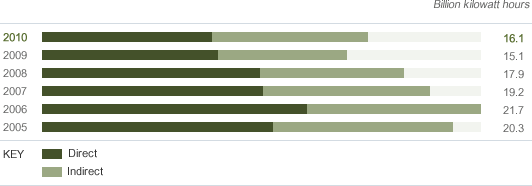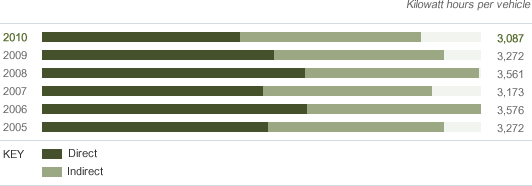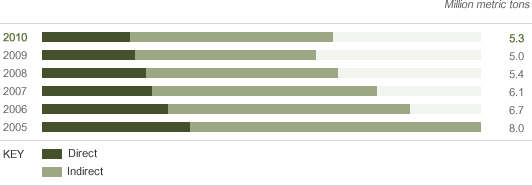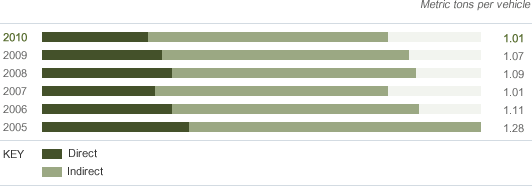Operational Energy Use and CO2 Emissions
Data on this page
A. Worldwide Facility Energy Consumption

Billion kilowatt hours
| 2005 | 2006 | 2007 | 2008 | 2009 | 2010 | |
|---|---|---|---|---|---|---|
| Total | 20.4 | 21.7 | 19.2 | 17.9 | 15.1 | 16.1 |
| Direct | 11.4 | 13.1 | 10.9 | 10.8 | 8.7 | 8.4 |
| Indirect | 8.9 | 8.6 | 8.3 | 7.1 | 6.4 | 7.7 |
- Data managed through the Global Emissions Manager database
Analysis
In 2010, overall global energy consumption increased by 6.6 percent compared to 2009, due primarily to a 13 percent increase in production volume. This increase followed a four-year declining trend. For more information, please see Progress and Performance – Facilities
Related Links
- In This Report:
B. Worldwide Facility Energy Consumption Per Vehicle

Kilowatt hours per vehicle
| 2005 | 2006 | 2007 | 2008 | 2009 | 2010 | |
|---|---|---|---|---|---|---|
| Total | 3,272 | 3,576 | 3,172 | 3,561 | 3,272 | 3,087 |
| Direct | 1,837 | 2,161 | 1,804 | 2,142 | 1,891 | 1,609 |
| Indirect | 1,435 | 1,415 | 1,369 | 1,419 | 1,381 | 1,478 |
- Data managed through the Global Emissions Manager database
Analysis
Our 2010 energy consumption per vehicle produced improved by 5.6 percent compared to 2009. These reductions were accomplished through a wide range of energy-efficiency projects. For more information, please see Progress and Performance – Facilities.
Related Links
- In This Report:
C. Worldwide Facility CO2 Emissions

Million metric tons
| 2005 | 2006 | 2007 | 2008 | 2009 | 2010 | |
|---|---|---|---|---|---|---|
| Total | 8.0 | 6.7 | 6.1 | 5.4 | 5.0 | 5.3 |
| Direct | 2.7 | 2.3 | 2.0 | 1.9 | 1.7 | 1.6 |
| Indirect | 5.3 | 4.4 | 4.1 | 3.5 | 3.3 | 3.7 |
- Third-party verified (North America and EU)1
- Reported to regulatory authorities (EU). Voluntarily reported to emissions registries or other authorities in Australia, Brazil, Canada, China, Mexico, the Philippines and the U.S.
Notes to Data
- Sixty-one percent of Ford's global facility GHG emissions are third-party verified. All of Ford’s North American GHG emissions data since 1998 are externally verified by The Financial Industry Regulatory Authority, the auditors of the NASDAQ stock exchange, as part of membership in the Chicago Climate Exchange. In addition, all of our European facilities impacted by the mandatory EU Trading Scheme are third-party verified.
Analysis
Facility CO2 emissions increased by approximately 6 percent due to production increases.
Related Links
- In This Report:
D. Worldwide Facility CO2 Emissions Per Vehicle

Metric tons per vehicle
| 2005 | 2006 | 2007 | 2008 | 2009 | 2010 | |
|---|---|---|---|---|---|---|
| Total | 1.28 | 1.11 | 1.01 | 1.09 | 1.07 | 1.01 |
| Direct | 0.43 | 0.38 | 0.33 | 0.38 | 0.35 | 0.31 |
| Indirect | 0.85 | 0.72 | 0.68 | 0.71 | 0.72 | 0.70 |
- Data managed through the Global Emissions Manager database
Analysis
CO2 emissions per vehicle declined for the third year, reflecting our focus on improving the energy efficiency of our operations. During 2010, we adopted a new goal to reduce global facility CO2 emissions per vehicle by 30 percent by 2025.
Related Links
- In This Report:
E. Energy Efficiency Index
Notes to Data
The North American Energy Efficiency Index is a normalized indicator based on a calculation that adjusts for typical variances in weather and vehicle production. The Index was set at 100 for the baseline year 2006 to simplify tracking against our annual 3 percent energy-efficiency target. A year 2000 baseline was used through 2006; the baseline will be reset to year 2010 starting in 2011. The year 2010 improvement indexed against the year 2006 baseline was 14.4, indicating a 14.4 percent improvement in energy efficiency since 2006.
Analysis
The 2010 North American Energy Efficiency Index value of 14.4% represents a decline in efficiency compared to the 18.3% in 2009. We attribute the decline to an over-adjustment in 2009 related to the dramatic drop in production. We know that our energy adjustment model tends to over-adjust for large drops in production that are managed using extended non-production periods. This is one of the key reasons to index against a typical baseline year rather than doing a year-over-year comparison. The long-term trend of our Energy Efficiency Index is very favorable.
Related Links
- In This Report:
- Overview
- Economy Data
- Environment Data
- Society Data

